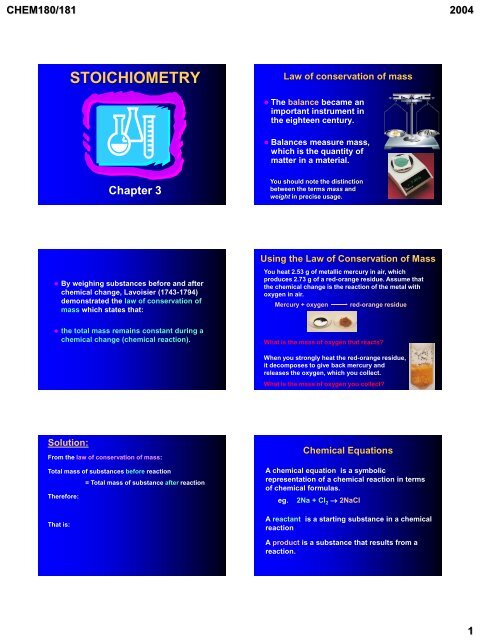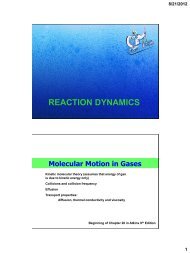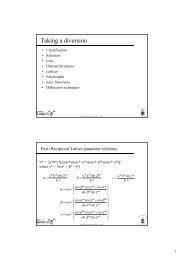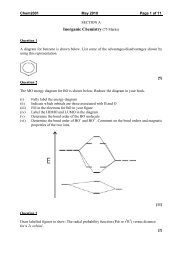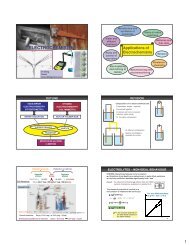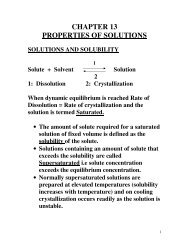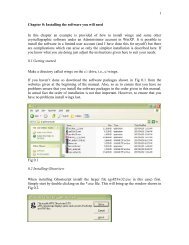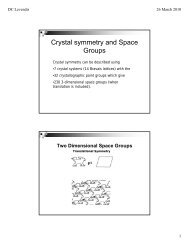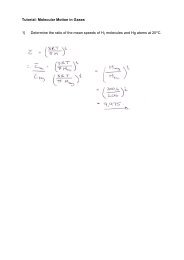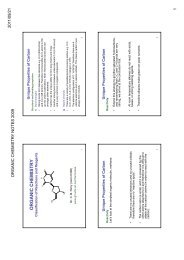STOICHIOMETRY
STOICHIOMETRY
STOICHIOMETRY
You also want an ePaper? Increase the reach of your titles
YUMPU automatically turns print PDFs into web optimized ePapers that Google loves.
CHEM180/181 2004<br />
<strong>STOICHIOMETRY</strong><br />
Law of conservation of mass<br />
• The balance became an<br />
important instrument in<br />
the eighteen century.<br />
• Balances measure mass,<br />
which is the quantity of<br />
matter in a material.<br />
Chapter 3<br />
You should note the distinction<br />
between the terms mass and<br />
weight in precise usage.<br />
• By weighing substances before and after<br />
chemical change, Lavoisier (1743-1794)<br />
demonstrated the law of conservation of<br />
mass which states that:<br />
Using the Law of Conservation of Mass<br />
You heat 2.53 g of metallic mercury in air, which<br />
produces 2.73 g of a red-orange residue. Assume that<br />
the chemical change is the reaction of the metal with<br />
oxygen in air.<br />
Mercury + oxygen<br />
red-orange residue<br />
• the total mass remains constant during a<br />
chemical change (chemical reaction).<br />
What is the mass of oxygen that reacts?<br />
When you strongly heat the red-orange residue,<br />
it decomposes to give back mercury and<br />
releases the oxygen, which you collect.<br />
What is the mass of oxygen you collect?<br />
Solution:<br />
From the law of conservation of mass:<br />
Total mass of substances before reaction<br />
= Total mass of substance after reaction<br />
Therefore:<br />
That is:<br />
Chemical Equations<br />
A chemical equation is a symbolic<br />
representation of a chemical reaction in terms<br />
of chemical formulas.<br />
eg.<br />
2Na + Cl 2 2NaCl<br />
A reactant is a starting substance in a chemical<br />
reaction<br />
A product is a substance that results from a<br />
reaction.<br />
1
CHEM180/181 2004<br />
Balancing Chemical Equations<br />
A chemical equation is said to be balanced,<br />
when the numbers of atoms of each element<br />
are equal on either side of the arrow.<br />
The state or phase of a substance may be<br />
indicated with one of the following labels:<br />
eg.<br />
(g) ; (I) ; (s) ; (aq)<br />
2Na(s) + Cl 2 (g) 2NaCl(s)<br />
Consider the burning of natural gas:<br />
CH 4 + O 2<br />
CO 2 + H 2 O<br />
You can also indicate the conditions under<br />
which a reaction takes place, as well as the<br />
presence of a catalyst.<br />
eg. 2H 2 O 2 (aq)<br />
Pt<br />
2H 2 O(l) + O 2 (g)<br />
Consider the burning or propane gas<br />
C 3 H 8 + O 2<br />
CO 2 + H 2 O<br />
To balance the equation, you select coefficients that<br />
will make the numbers of atoms of each element equal<br />
on both sides of the equation.<br />
Balancing Simple Equations<br />
Balance the following equations:<br />
C 3 H 8 + O 2<br />
C 3 H 8 + O 2<br />
CO 2 + H 2 O<br />
CO 2 + H 2 O<br />
CS 2 + O 2 CO 2 + SO 2<br />
C 2 H 5 OH + O 2<br />
CO 2 + H 2 O<br />
Now have<br />
C 3 H 8 + O 2 CO 2 + H 2 O BALANCED<br />
NH 3 + O 2<br />
NH 3 + O 2<br />
NO + H 2 O<br />
NO + H 2 O<br />
Atomic Weights & Molecular Weights<br />
Central to Dalton’s atomic theory was the idea<br />
that each atom had a characteristic mass.<br />
We now know that each isotope has its own<br />
characteristic mass. Dalton actually calculated<br />
the average atomic mass, based on the relative<br />
abundance of each isotope.<br />
Dalton could not weigh individual atoms,<br />
instead he could find the average mass of one<br />
atom relative to the average mass of another.<br />
(using H as a base)<br />
Atomic mass unit - amu<br />
Today based on carbon-12<br />
Mass of 12 C = 12 amu<br />
1<br />
1 amu = 12 mass of 12 C<br />
The atomic weight of an element, is the<br />
average atomic mass for the naturally<br />
occurring element, expressed in atomic mass<br />
units.<br />
2
CHEM180/181 2004<br />
Fractional Abundance<br />
The fractional abundance of an isotope is the<br />
fraction of the total number of atoms that is<br />
composed of a particular isotope<br />
Alternate Example<br />
An element has four naturally occurring<br />
isotopes. The mass and percentage<br />
abundance of each isotope are as follows:<br />
Percentage abundance<br />
Mass<br />
1.50 203.973<br />
23.6 205.9745<br />
22.6 206.9745<br />
52.3 207.9766<br />
What is the atomic weight and the name of<br />
the element?<br />
The mass percentages sums to 100<br />
ie. 1.48 + 23.6 + 22.6 + 52.3 = 99.98<br />
= 100 (SIG FIG’S)<br />
Percentage Composition<br />
Percentage composition of a compound = the<br />
percentage by mass contributed by each<br />
element in the substance<br />
The percentage of element B Is defined as:<br />
(Atoms of B)(AW of B)<br />
Mass % B =<br />
mass of the whole<br />
x 100%<br />
Atomic weight = Therefore the element is :<br />
Remember the sum of the percentages of each<br />
element in the substance add up to 100%<br />
Example<br />
Lead(II)chromate is used as a paint pigment<br />
(chrome yellow). What is the percentage<br />
composition of lead(II)chromate?<br />
The chemical name for table sugar is sucrose,<br />
C 12 H 22 O 11 . How many grams of carbon are in<br />
61.8 g of sucrose?<br />
Lead(II)chromate = PbCrO 4<br />
A r (Pb) = 207.2 g/mol<br />
A r (Cr) = 51.9961 g/mol<br />
A r (O) = 15.9994 g/mol<br />
%Pb =<br />
M r (PbCrO 4 )<br />
=<br />
%Cr =<br />
Consider 1 mol of<br />
PbCrO 4<br />
%O =<br />
3
CHEM180/181 2004<br />
Mass and Moles of Substance<br />
• We have seen so far that atoms / molecules<br />
react in simple ratios.<br />
• Atoms and molecules are too small to count.<br />
• We need find another way of expressing<br />
such large numbers<br />
In pursuit of this end we are going to consider<br />
the following concepts:<br />
• Molecular weight<br />
• Formula weight<br />
• the Chemical Mole<br />
Formula and Molecular Weight<br />
The formula weight of a substance is the sum<br />
of the atomic weights of all atoms in a formula<br />
unit of the compound.<br />
The molecular weight of a substance is the<br />
sum of the atomic weights of all the atoms in a<br />
molecule of the substance.<br />
Note: the formula weight is<br />
applicable to both molecular and<br />
ionic compounds.<br />
Example<br />
Calculate the formula weight of the following<br />
compounds from their formulae:<br />
b) methylamine = CH 3 NH 2<br />
a) calcium hydroxide<br />
The Mole<br />
Chemists have adopted the mole<br />
concept as a convenient way to<br />
deal with the enormous numbers<br />
of atoms, molecules or ions in<br />
the samples they work with.<br />
Definition of Mole:<br />
A mole (symbol mol) = the amount of matter<br />
that contains as many Objects (atoms,<br />
molecules etc) as the number of atoms in<br />
exactly 12 grams of carbon-12.<br />
The number of atoms in a 12 gram sample of<br />
carbon-12 is called Avogadro’s number (N A )<br />
The term mole, just like a dozen or gross,<br />
refers to a particular number of things.<br />
one dozen = 12<br />
one gross = 144<br />
one mole = 6.0221367 x 10 23<br />
Avogadro’s number (N A )<br />
When using the term mole it is important to<br />
specify what is being referred to!<br />
eg : 1 mol of CH 3 COOH molecules contains<br />
2 moles of C atoms etc.<br />
4
CHEM180/181 2004<br />
The molar mass of a substance is the mass of<br />
one mole of the substance<br />
For all substances, the molar mass in grams<br />
per mole is numerically equal to the formula<br />
weight in atomic mass units.<br />
Calculating the Mass of an Atom or<br />
Molecule<br />
What is the mass of a nitric acid molecule?<br />
nitric acid =<br />
Mole Calculations<br />
Because molar mass is the mass per mole we<br />
have the formula:<br />
Molar Mass =<br />
Mass<br />
Moles<br />
or M r =<br />
m<br />
n<br />
Example<br />
Converting Grams of Substance to Moles<br />
Calcite is a mineral composed of calcium<br />
carbonate, CaCO 3 . A sample of calcite<br />
composed of pure CaCO 3 weighs 23.6 g. How<br />
many moles of calcium carbonate is this?<br />
Remember that mass must be expressed in<br />
grams here!<br />
Converting Moles of Substance to Grams<br />
A sample of nitric acid contains 0.253 mol<br />
HNO 3 . How many grams is this?<br />
M r (HNO 3 ) = 63.013 g.mol -1<br />
Example<br />
(see previous example)<br />
Example<br />
Calculating the Number of Molecules in a Given<br />
Mass<br />
The daily requirement of chromium in the<br />
human diet is 1.0x10 -6 g. How many atoms of<br />
chromium does this represent?<br />
n = 0.253 mol<br />
5
CHEM180/181 2004<br />
Determining formulae<br />
The percentage composition of a compound<br />
leads directly to its empirical formula.<br />
Recall: An empirical formula for a compound<br />
is the formula of a substance written with the<br />
smallest integer subscripts.<br />
Eg. Consider hydrogen peroxide:<br />
Molecular formula = H 2 O 2<br />
Empirical formula = HO<br />
Compounds with different molecular formulae<br />
can have the same empirical formula, and<br />
such substances will have the same<br />
percentage composition.<br />
Eg. acetylene = C 2 H 2<br />
benzene = C 6 H 6<br />
both have the empirical formula =<br />
Empirical formula from Composition<br />
Consider the following flow-diagram:<br />
Percent composition<br />
Mass Composition<br />
Number of moles of<br />
each element<br />
Example<br />
Determining the Empirical Formula from the<br />
Masses of Elements (Binary Compound)<br />
We have determined the percentage<br />
composition of benzene: 92.3% C and 7.7% H.<br />
What is the empirical formula of benzene?<br />
Divide by smallest number of<br />
moles to find the molar ratios<br />
Multiply by appropriate number to<br />
get whole number subscripts<br />
Ratio C : H = Empirical Formula =<br />
Example<br />
Determining The Empirical Formula from<br />
Percentage Composition. (General)<br />
Sodium pyrophosphate is used in detergent<br />
preparations. The mass percentages of the<br />
elements in this compound are 34.6% Na,<br />
23.3% P and 42.1%O. What is the empirical<br />
formula of sodium pyrophosphate?<br />
Hint: Consider a 100 g sample.<br />
Molecular Formula from Empirical<br />
Formula<br />
The molecular formula of a compound is a<br />
multiple of its empirical formula.<br />
Molecular weight = n x empirical formula weight<br />
where n = number of empirical formula units<br />
in the molecule.<br />
6
CHEM180/181 2004<br />
Example<br />
Determining the Molecular Formula from the<br />
Percentage Composition and Molecular Weight.<br />
We have already determined the mass<br />
composition and empirical formula of benzene.<br />
In a separate experiment, the molecular weight<br />
of benzene was determined to be 78.1. What is<br />
the molecular formula of benzene<br />
Empirical Formula = formula weight =<br />
Stoichiometry<br />
Stoichiometry is the calculation of the<br />
quantities of reactants and products involved in<br />
a chemical reaction<br />
It is based on the chemical equation and the<br />
relationship between mass and moles.<br />
We can interpret a chemical equation in terms of<br />
number of molecules (or ions or formula units) or in<br />
terms of number of moles of molecules etc. depending<br />
on our needs.<br />
Remember that because moles can be converted to<br />
mass, we can also produce a mass interpretation of a<br />
chemical equation.<br />
Consider the reaction:<br />
N 2 (g) + 3H 2 (g) 2NH 3 (g)<br />
Molecular Interpretation:<br />
1 molecule N 2 + 3 molecules H 2 2 molecules NH 3<br />
Molar interpretation:<br />
1 mol N 2 + 3 mol H 2 2 mol NH 3<br />
Mass interpretation:<br />
28.0 g N 2 + 3 x 2.02 g H 2 2 x 17.0 g NH 3<br />
Example<br />
Amounts of Substance in a Chemical Reaction<br />
Find the amount of water produced when 3.68<br />
mol of NH 3 is consumed according to the<br />
following equation:<br />
4NH 3 + 5O 2<br />
4 NO + 6H 2 O<br />
We assume that sufficient O 2 is present.<br />
From the equation we know that :<br />
Notice that :<br />
The number of moles involved in a reaction is<br />
proportional to the coefficients in the balanced chemical<br />
equation.<br />
The Steps in a Stoichiometric<br />
Calculation<br />
Mass of substance A<br />
Moles of substance A<br />
Use molar mass of A<br />
Use coefficients of A & B in<br />
balanced eqn<br />
Moles of substance B<br />
Example<br />
Calculate the mass of sulfur dioxide (SO 2 )<br />
produced when 3.84 mol O 2 is reacted with<br />
FeS 2 according to the equation:<br />
4FeS 2 + 11O 2 2Fe 2 O 3 + 8SO 2<br />
3.84 mol m = ?<br />
2.79 mol<br />
Mass of substance B<br />
Use molar mass of B<br />
7
CHEM180/181 2004<br />
Another Example<br />
One of the most spectacular reactions of<br />
aluminium, the thermite reaction, is with iron<br />
oxide, Fe 2 O 3 , by which metallic iron is made.<br />
The equation is :<br />
2Al(s) + Fe 2 O 3 (s)<br />
Al 2 O 3 (s) + 2Fe(l)<br />
A certain welding operation, requires that at least 86.0 g<br />
of Fe be produced. What is the minimum mass in grams<br />
of Fe 2 O 3 that must be used for the operation?<br />
Calculate also how many grams of aluminium are<br />
needed.<br />
Strategy:<br />
2Al(s) + Fe 2 O 3 (s)<br />
mass of Fe mol of Fe<br />
mol of Fe mol of Fe 2 O 3<br />
Al 2 O 3 (s) + 2Fe(l)<br />
Limiting Reactants<br />
The limiting reactant (or limiting reagent) is<br />
the reactant that is entirely consumed when a<br />
reaction goes to completion.<br />
mol of Fe 2 O 3 mass of Fe 2 O 3<br />
The moles of product are always determined<br />
by the starting moles of the limiting reactant.<br />
The Cheese Sandwich Analogy<br />
Which is the limiting reactant?<br />
Strategy:<br />
• Use the relationships from the balanced<br />
chemical equation<br />
• You take each reactant in turn and ask how<br />
much product would be obtain, if each were<br />
totally consumed.<br />
• The reactant that gives the smaller amount<br />
of product is the limiting reactant.<br />
8
CHEM180/181 2004<br />
Example<br />
Example<br />
More Challenging!!<br />
When 100.0 g mercury is reacted with 100.0 g<br />
bromine to form mercuric bromide, which is<br />
the limiting reagent?<br />
Hg + Br 2 HgBr 2<br />
Iron can be obtained by reacting the ore<br />
heamatite (Fe 2 O 3 ) with coke (C). The latter is<br />
converted to CO 2 . As manager of a blast<br />
furnace you are told that you have 20.5 Mg of<br />
Fe 2 O 3 and 2.84 Mg of coke on hand.<br />
(a) Which should you order first - another<br />
shipment of iron ore or coke?<br />
Thus the limiting reagent is<br />
(b) How many megagrams of iron can you<br />
make with the materials you have?<br />
2Fe 2 O 3 + 3C 4Fe + 3CO 2<br />
(b) How many megagrams of iron can you<br />
make with the materials you have?<br />
Recommended tut questions<br />
2.17 3.1 3.35<br />
2.18 3.5 3.59<br />
2.26 3.21 3.63<br />
2.27 3.27 3.96<br />
3.33<br />
9


